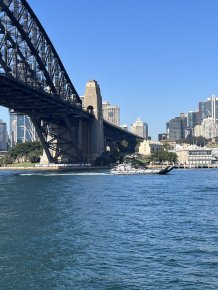All of which is why I spat the dummy and resigned from the RAN!Reading the carbinet papers relating to the carrier replacement are an eye opener. Others (Spoz & Assail) may be able to add further insight, but basically the deputy chief scientist, department of primeminister and cabinet, and the RAAF representative provided advice to government, in 1982, that killed the carrier replacement program.
The government of the day didn't make a decision at the time as an election was approaching, but the overwhelming advice and sentiment, was not to replace Melbourne, especially as Invincible was nolonger available.
The key elements were:
1. The Harrier was useless, inferior to the F-5 Tiger etc. because it wasn't supersonic.
2. Helicopters were inferior to fixed wing ASW aircraft because dipping sonar was inferior to the "Barra" sonar buoy.
3. The only carrier worth getting, therefore, was one that could operate supersonic fighters and fixed wing ASW aircraft.
4. A conventionally powered CTOL version of a French design (that became CdeG) was the only viable solution, but too expensive.
5. In the current economic environment Australia couldn't afford to acquire such a ship, especially as acquiring an additional 10 P-3C aircraft ( which in their opinion were far superior at ASW than the RAN as a whole) was a much higher priority and Australia couldn't afford both.
Further to this:
1. Without supersonic fighter cover, even guided missile destroyers were too vulnerable to operate.
2. Being inferior to land based MPA aircraft, naval ASW helicopters weren't worth operating.
3. The RAN would have to become a coastal force, operating within Australian waters, under RAAF air cover.
4. This was a price worth paying to have a modern, effective air force.
Today these arguments would be ripped apart by a twelve year old using Google but back then they were the authoritive opinions of the experts on airpower, backed by the preeminent defence scientist. This was also following the preliminary information from the Falklands conflict.
Just as many unsubstantiated claims are being made about the future of warfare based on events in Ukraine, the Falklands some how was twisted to indicate that surface ships were unsurvivable and airpower was king.
The replacement carrier was gone, the ability to take effective ASW helicopters to sea was gone. The ability to triangulate to effectively use Ikara at longer range was gone.
Surface combatants were seen as incapable of defending themselves, therefore a waste of resources.
A follow on of losing the carrier, was losing justification for additional FFGs, there were initially meant to be ten (six instead of only two Australian built ships), plus the three DDGs and four US built FFGs. Also, initial plans to supplement the patrol boats with missile armed FACs died at the same time.
If memory serves, it was actually proposed to build a pair of Dutch M Class frigates instead of the last two FFGs. This was because the air power mafia had "proven" guided missile ships were a waste of resources.
The sad fact is, the Dibb report and the following white paper, actually improved things for the RAN from where they were heading. The RAN had done a very good job if convincing the political classes that a navy without a carrier, wasn't a navy. When the choice was made, based on advice not to replace the carrier, the navy, by its own statements, had become irrelevant.
These decisions seemed to have had the support of the people during the Bob Hawke love in period so ……if they didn’t care.,.
Being an ASW specialist was a dead end in these circumstances.
Last edited:



